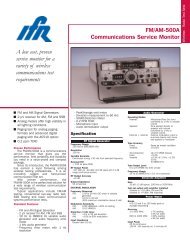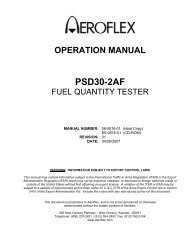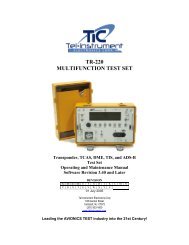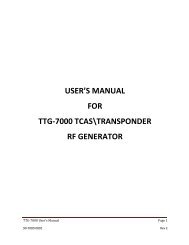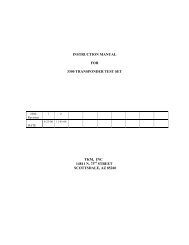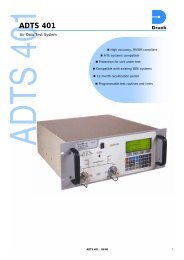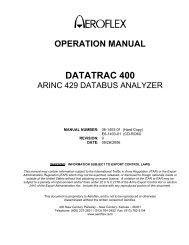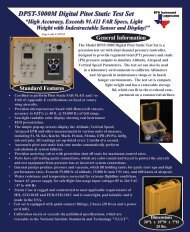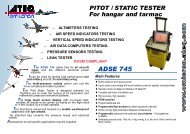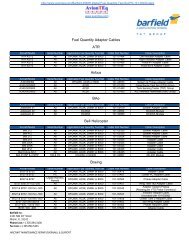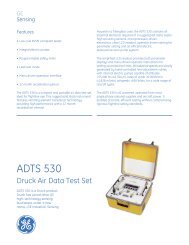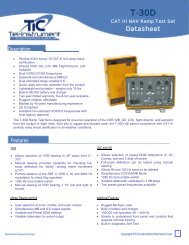view D60253 operations manual - AvionTEq
view D60253 operations manual - AvionTEq
view D60253 operations manual - AvionTEq
- No tags were found...
You also want an ePaper? Increase the reach of your titles
YUMPU automatically turns print PDFs into web optimized ePapers that Google loves.
Pennyf6ilesf"c:::';;.if.;h"'.'.. . 7AliofliCs Sysfems Division6.0 SYSTEM FAULT DETECTION 47Page6.1 Input Error Detection .......•....•....... 497 • 0 POWER FAILURE . . . . . . . . . . . . . . . . . . . . . . . . . . . . . . . . . .. 518.0 USEFUL HINTS FOR OPERATION OF TEST SET8.1 QFE Reading ,0 • • •• 528.2 Altitude Alert/Altitude Switch Points 528.3 Stall Warning/Airspeed Switches .••....... 528.4 Leak Checks • • . . . . . . . . . . . . . . . . . . . . . . . . . . .. 529.0 PIPE CONNECTIONS9.1 Airspeed Indicator Calibration Checks 539.2 Altimeter Calibration Checks ......•...... 539.3 VSI Calibration ........................•. 53Fig.!.Fig.2.Fig.3.Front Panel Layout . . . . . . . . .. . . . . . . . . . . . . . . . . . .. 54Remote Control & Display Unit .....•.......•..• 55printer Connection .•..•.............•..•...•.. 5619 May 1989Rev: 1 10 Dec 1990PUB 121Page 3
PennyfGiles11,~,l";{')'~~\iiW~~~~ ~ r.. ,.•~' IAvionics SystemsDivision1.0 DESCRIPTIONThe Computer Controlled Air Data Test Set (CCADTS) has beendesigned to be sufficiently rugged for 1st line on aircraftapplications with accuracy suitable for 2nd and 3rd lineworkshop use.The CCADTS is a self contained unit for use withvacuum and pressure supplies.externalThe CCADTS comprisescontrols, sensors andof a main unitcomputer, with ahousing pneumaticseparate compactremote control and display unit. The CCADTS may be used ineither of two formats.(i) With the Remote Control and Display Unit (RCDU)mounted directly onto the front of the mainCalibrator /Control Unit (CCU), which is its normaloperating and storage position.(ii) with the RCDU operating up to 25m from theconnected via an optional electrical cable.this mode 1st line testing of equipmentsimplified by taking just the RCDU intoaircraft, with the main CCU remaining outside.CCU,InistheThe fold-out sheet (Fig. 1), at the back of this instruction<strong>manual</strong>, shows the front panel layout of the test set with theRCDU fixed to the main CCU.The control and measurement system is based on a 16 bitprocessor and circuitry developed for airborne primary airdata computers. The pressure sensors employed in the CCADTSare designed for air data applications. There are three suchsensors used, two being of the vibrating cylinder type, and athird to monitor differential pressures, providing accuratemeasurement of airspeed down to 20 knots. This transducer isof the type used in the Penny and Giles pitot-static test setcurrently in use with military and civil helicopter operatorsworld wide.The RCDU housing is compact and easily handled in theaircraft flight deck, environment. The optionalinterconnecting lead between RCDU and CCU is a customdesigned multicore coaxial cable to ensure resistance toaviation hydraulic liquids. The equipment has been designedto ensure electromagnetic compatability within the expectedaviation environment.A dedicated printer is available which, when selected,allow direct copies of screen displays to be made.Section 3.3 below.willSee19 May 1989Rev: 1 10 Dec 1990PUB 121Page 4
PennyfGiles, '.';'~~1il':i.i{i~F·i';'·;':-,-,·'·. '~ " . 7Avionics SystemsDivision2.0 INSTALLATIONOf'CALIBRATOR/CONTROL UNITpitot and static connections are made via the 7/16" - 20 UNFPitot port and the 1/2" - 20 UNF Static port (see Chapter 9.0"Pipe Connections"). Self-sealing connectors, which affordprotection for the CCADTS, and the unit under test, in theevent of inadvertent disconnection, are available.External vacuum and pressure connections are made1/2" - 20 UNF Vacuum port and the 7/16" - 20 UNFport. The services required are:-via thePressure1) Vacuum: Less than 20 mB abs. and capableof attaining desired flow rates;and 2) Pressure: 2.6 to 3.'0 bar clean, dry air.Externally generated pressure and vacuum supplies must beconnected to the 'external pressure' a~ 'external vacuum'ports, to enable operation. .. ;/
PennyfGilest:::·,,4oV@lt';tiM!#~i~-:.i:~ .. r~
Pennyf-Gi!es.' -f'1. ':
PennyfGilesI .,.C(\~.'lS;i,'''.'' .'~A·,·.:;':;~-:"i.!_·· . 7Aldonics SystemsDivisionAfter about five seconds, during which tim~ the systemperforms a check of internal circuitry and memory banks, thedisplay changes to allow input of the required operatinglimits and ensure protection of the unit under test.Should the display not change, then the self test routine hasdetected a fault and the unit should be referred to anauthorised service centre. The software number and its issuenumber should be quoted in any correspondence together withthe serial number of the CCADTS unit.Page 8PUB. 12119 May 1989
Penny+6i/esAvionics SystemsDivision3.1.1 OPERATING LIMITSWhen the CCADTS is initially powered up, and after it hassuccessfully completed its internal checks, it will displaythe 'Enter Operating Limits' page. This presents theopportunity to define the maximum operating envelope for theCCADTS during subsequent tests.The unit is supplied with a set of default maximum limits.These may be retained by pressing ES when the cursor isalong-side each parameter. If the value is desired to bechanged, this should be done by typing the new limit followedby ES, until all parameters have been defined.The cursor will flash alongside the parameter to be entered.The default values are displayed. These may be accepted bypressing ES on the keyboard, or alternative values entered bypressing the appropriate keys, followed by ES.When all values have been entered the user is given theopportunity to re-start the alteration procedure by pressingAP. If all values are as required, continue by pressing ES.The display now changes to the main menu as follows.Page 9PUB. 12119 May 1989
Penny+Giles_iiiiiijjiiiliiliiiiiiiiiiiliilliii]Avionics Systems Division3.2 KEYBOARD OPERATIONvarious control modes may be selected from the main menupresented on the video screen.The keyboard on the RCDU consists of 4x4 key array withnumbers 0-9, +/-, and decimal point. The four keys in thebottom line of the keyboard are all control function keys.The ES key is the Enter Set parameter key. This key is alsopressed to start pressurisation during control procedures.The CL key is a Clear key. This is used to clear anyfigures entered in error. This key is also used as an abortkey, should the user wish to stop any Test Set process at anytime. When CL is pressed twice in quick succession, thesystem will return to the main menu and hold the pressurescurrently in the system to allow the operator to decide thenext course of action. (The instruction pages may be read atthis point).The AP key is used to alter parameters, and is pressed beforeinputting new data (eg. new target pressures, etc.).FN is used to access a number of function options see"Function utilities", section 5.0.Page 10PUB. 12119 May 1989
PennyfGl7es/- ' ",'-";',~ft,,"Si"uWk#J$.w.r;WfrU.\\.A~1:.1t~·:(l.::~1Avionics SystemsDMsion3.3 PRINTER OPTIONThe printer is factory set, to interface with the CCADTS, andthe settings should not be altered. A print of the screenwill be effected by pressing the "PRINT" button on theprinter.19 May 1989Rev: 1 10 Dec 1990PUB 121Page 11
PennyfGiles/ "~ ·;il.~,,,q*t~"!:':'l.'V',l-~"';;'\tm:J._~·:::·:~-",.' .;'?t.:;\-,"/Avionics SystemsDivision\4.0 MAIN MENU (Operating Modes)The lines at the bottom of the screen provide information forthe user. A 'status line' on the bottom line of the screenis displayed whenever the main menu is on the screen. Thisindicates whether the system is currently pressurised orvented. It also displays "OPTION NOT FITTED" if the userattempts to enter a function not incorporated into this testset.Page 12PUB. 12119 May 1989
PennyfGilesfr·.f:'..d,;~';/f('Pl.S!~· L -':'.'" .' ~~Itl.~~· . .W~';;i'·~J.,·t('(~:.)j( 7Avionics SystemsDivisionNo pipes should be removed from the CCADTS until 'SYSTEMVENTED' is displayed on the status line.Above the status line are two 'user prompt' lines. Themessages displayed in these two lines provide information toaid the user in operating the CCADTS, and the next course ofaction (e.g. "press key of choice").In pressure controlling modes, the bottom line displays notonly status information, but is also used to report errorconditions, where appropriate.Page 13PUB. 12119 May 1989
Pennyf6iles···;~lt;~~~,'l:'\\'!:'.' ~:-:"": IAvionics SystemsDivision4.1 MAIN MENU KEY 1 - Operating InstructionsOption number 1 allows access to the basic operatinginstructions which consist of a number of pages as follows:Page 14PUB. 12119 May 1989
PennyfGiles. "::::;'\'."i,'; '. u ,-,'.':-',' .:' ".;;~:.!.t~-::. IAvionics SystemsDivisionTo continue, press ES or, alternatively, the user may returnto the Main Menu by pressing CL twice in quick succession.Page 15PUB. 12119 May 1989
PennyfGilesI /Avionics Systems DivisionPage 16PUB. 12119 May 1989
Penny+6iles/ 7Avionics Systems DivisionPage 17PUB. 12119 May 1989
Penny+Gi/esc 7Avionics Systems DivisionPage 18PUB. 12119 May 1989
Penny-fGi/es/ IAvionics Systems DivisionPage 1919PUB.May1211989
Penny/Giles. IAwonics Systems DivisionThese instructions should give basic assistance should theuser experience problems during use and they may be displayedwithout effecting any functional test, by selecting Key 1 onmain menu. Note that any pressures in the system will beheld indefinitely while the instruction pages are displayed.Page 20PUB. 12119 May 1989
Penny-fGilesp.; ':;"". '1(..~,"~.~~"'J;Hki~'iMW!,:~..;g~8..'VN;y.O,'~i
Penny+6i/est JI,.~I!j~,r~&~»MfblJM~Jk~~~i.lmJl~~;rq.\P;$~~·llft~·~?,"W: rlAvionics SystemsDivision4.4 MAIN MENU KEY 4 - Measure Only ModeOption number 4 switches off the pressure control functionand the test set adopts a pressure monitoring role to enablecalibration of other pressure generating equipment, and tomonitor pressures within the system.It is necessary that external pressure and vacuum suppliesare connected when using this mode to ensure that the vacuumand pressure reservoirs are at the correct level to revertback to control mode at any time.To return to Main Menu press CL twice in quick succession.Page 22PUB. 12119 May 1989
PennyfGiles1,~,·,,·':'t'~-:w.~~hll·,b;t~j4{il!l:itiV{F@fW~~.'7.r"",~>:;~~~}:"1.~lAvionics SystemsDivision4.5 MAIN MENU KEY 5 - Vent Pressure LinesOption number 5 vents both pitot and static lines down toambient pressure at the pre-set maximum rates entered atstart up or updated via option 2 from the Main Menu.To abort the Vent routine and return to the Main Menu,CL twice in quick succession.pressPage 23PUB. 12119 May 1989
Penny+6iles1:;;'Jl!~~m~jf~,rli\.~'#.ftWtm¥t~MW4l~;\~,{'4~·1;.~·),!J,~IVAvionics SystemsDivisionThe value of the last vent level (ie: QFE) is stored withinthe unit. When a new vent is selected, the system firstvents to the last recorded figure. If the new QFE reading isdifferent from the stored value, the system will slowly alterthe pressures in the lines until internal and externalpressures are matched, and the unit is vented.As in the main menu, the "status" line indicates when thesystem is vented.Page 24PUB. 12119 May 1989
PennyfGilesI ". . :''J:I'NN!'jp.:-· ,,',(...ggE¥iS&~'f,i;.;,:,."\;i.::-· ':" -",' : 7Avionics SystemsDivision4.6 MAIN MENU KEY 6 - Leak Check Pressure LinesLeak checks may be carried out at any time, and at anypressures within the limits previously defined.The units displayed with the leak routine are controlled viaKey 3, "Selection of Units", in the main menu. The displayedleak-rate units are dependant upon the units selected asfollows:-PARAMETER UNITS SELECTED LEAK-RATE UNITSfeetfeet/minmm/minAltitude rob rob/mininHginHg/minpsipsi/minknotsknots/minkm/hrkm/h/minAirspeed rob rob/mininHginHg/minpsipsi/minA rapid indication as to the existence of any leakage may beobtained by selecting 4 on the main menu and entering theMeasure-Only-Mode, which will allow the monitoring ofpressure within the system.NOTE: During Leak Checks, including Measure-Only-Mode use,with altitudes above ground level, ensure that anominal positive airspeed (say 100kn) is present toavoid the possibility of Airspeed out-of-rangeconditions arising. Alternatively, engage Fixed-Wingrange, as shown in Section 4.7.3 below, to minimisethe effect.19 May 1989Rev: 1 10 Dec 1990PUB 121Page 25
PennyfGiles/~:m~~~~i\£i~g'f-~":i:iiI;i~~~·I?~i'.j'$'l~.~):.l:z!}~X!#:o;'i-.r.;:i,\,!:·~f1;~: 7Avionics SystemsDivisionHowever to carry out a full leak check and provide indicationof leak rates then selection of option number 6 enters theleak check routine and displays the following:Upon entry to this routine the pressures currently in thesystem are displayed with the cursor flashing alongside theparameter to be entered. The current value may be acceptedby pressing ES or changed by pressing the appropriate keysfollowed by ES to enter the value. The cursor will now moveto the set indicated airspeed required which is entered inthe same way. If both pressures are as required pressing ESwill commence the leak check routine. If pressures otherthan those currently in the system have been selected thedisplay will update until those pressures are achieved.To abort the Leak Check routine and return to the mainpress, CL twice in quick succession.menu,Page 26PUB. 12119 May 1989
Penny+6i1es: -',;:,;,-:v,;.:
Penny+GilesI ~Avionics Systems DivisionAssuming there are no large leaks in the system,pressurisation will contine until the target pressures areachieved when the display will change to the following.Thewilldisplay will indicate a period of volume settlement .andcontinue to show the countdown of time remaining.Page 28PUB. 12119 May 1989
Penny/Gilesl·~.~:hl?*~}'"l,~»J~J')~i'!~M)~-:~.'("i~~.\&o?tlh~(~~:x-t4..'S!~r~;.>; ~. ..... - 7Avionics SystemsDivisionThis period is to ensure stability within the pressure systemto accurately monitor leak rates. During this period ofvolume settlement (approx 3 mins.) the test set is monitoringthe leak rate and should this be in excess of 5mb/min(185ft/at 10Kft) the test is aborted and an indication giventhat there is a system leak, and which line is leaking.If not aborted, the period of volume settlement will continueuntil complete, at which time the display will change toindicate that the unit is now measuring any leaks in thesystem. This takes a further minute after which time theleak rates are displayed in the appropriate units.Page 29PUB. 12119 May 1989
PennyfGiles7Avionics Systems DivisionShould10Kft)screen.thethisleak rate be in excess of 1mb/min (37ft/minis highlighted by flag at the bottom ofatthePage 30PUB. 12119 May 1989
PennyfGilesk~.r~":...:r$~~~~if-'~*,i"':R1i1;F"'~J..,?!;~~~V1~if,{\1 ~\.~ _r·.t~~.::::l ;!(,,',' :')~~·'·IAvionics Systems DivisionThe screen also indicates that the test has been completedTo continue, press ES. Should the user wish to repeat thetest this option is available by pressing AP. Alternatively,the user may return to the Main Menu by pressing CL twice inquick succession.Page 31PUB. 12119 May 1989
Penny+6i1esp-..',,"~~ j;.~;r.:."';~-':-~U-~'ff{!d'4~~~nr:D~).W~'""4,'1'1·. i /Avionics SystemsDivision4.7 MAIN MENU KEY 7 - User ControlOption number 7 enters the User Control, via keyboardfacility, enabling the user to pressurise the system, eitherin one of four parameters or in all parameters. Uponselection of this mode, a sub menu is displayed.The user control via keyboard mode uses the same screenformat for all operating modes. The screen is divided intotwo parts. The top half displays the user selected targetvalues of pressure. The bottom half displays the measuredpressures currently in the system. As is usual, two promptlines are displayed at the bottom of the screen and anerror/status line below these, on the bottom line.The status line indicates error conditions as well asconditions such as "PRESSURE ACHIEVED". This PressureAchieved flag is displayed when the measured pressure isequal to the set (or target) pressure. The measured pressureis allowed to drift 10 feet and/or 1 knot from the setpressure at which point the pressure achieved flag will goout until pressure is re-achieved.Target values may always be altered at any stage of controlby pressing AP, and accepted by pressing ES. After parameteralteration, the control mode is initiated by pressing ES.Page 32PUB. 12119 May 1989
Pennyf6iles1;;":(,\~"4\":&-iJ-:·~~~.\~"f~:';:.;('~:l':0,.'~'~~· ·+;-'::;·f,r;·"4,·~ " 7Avionics SystemsDivision4.7.1 USER CONTROL KEY 1 - Control Atitude/Static PressureWhen Key 1 is pressed control of static pressure is possible.Upon entry to a control routine the pressures currently inthe system are displayed and maintained.To alter a set parameter press AP. The cursor will flashalongside the set altitude parameter. The new value requiredshould be entered by pressing the appropriate keys followedby ES.Page 33PUB. 12119 May 1989
PenflY+6i1esI 7AVlOntC0 Systems DivisionThe system then allows the user to re-start the alterationroutine by pressing AP or to continue and achieve the. setparameter by pressing ES.Page 34PUB. 12119 May 1989
Pennyf6iles1- ," \'-"'.:>'i'lnf.:..:;-));e:\:Y5t: -..,; :"-'.~·(i·.~'.l'~·':~~,~,.~· IAvionics SystemsDivisionAt any time during the control mode pressure generation maybe halted by:(i) Pressing AP which causes the cursor to flashalongside the set parameter. Pressure control can thenbe re-started by re-entering the set point (pressES) or altering the set parameter and then pressing ES.(ii) Pressing the CL key twice in quick succession whichreturns the CCADTS to the main menu and holds pressurein the system.Page 35PUB. 12119 May 1989
Penny+Giles/. '-~?i~~:if~~l'.~~.~'.:;~liih;-"Sb::-\.- .-. ~:&l~·. ~., . 7Avionics SystemsDivision4.7.2 USER CONTROL KEY 2 - Control Rate of ClimbWhen Key 2 is selected rate of climb checks are possible.Entry into this routine displays the following:The set altitude displays current pressures within thesystem. To alter the set parameters, press AP. The cursorwill flash firstly alongside the set altitude. The user hasto select a target altitude and enter this figure by pressingES. The cursor now moves to alongside the Set altitude rate.The required altitude rate should now be entered. If allvalues are correct the system may be started by pressing ESto continue. When the requested rate of climb is achieved,the "RATE ACHIEVED" flag is displayed.NOTE:An altitude has to be selected great enough to allowsufficient time to achieve the requested rate. The larger therequested rate, the larger the difference between the targetaltitude and current altitude should be.Page 36PUB. 12119 May 1989
Penny+611es~Avionics SystemsDivisionThe process may be stopped at anytime by pressing AP andre-entering new values of altitude rate.Page 37PUB. 12119 May 1989
PennyfGiles/':·~!·~'~;","',~';,...'!~~·;::t]'h·';f->'·IAvionics•SystemsDivision4.7.3 USER CONTROL KEY 3 - Control Airspeed/DynamicPressureEntry into this routine produces the following display:.-The procedure to alter parameters and enter set points isexactly as previously described with the prompt lines aidingthe user. Airspeeds below 20kn are considered to be zero andthe system is balanced. It is possible to enter zero Knotsas a command value. The "PRESSURE ACHIEVED" flag willoperate at any measured value less than 20kn when the commandvalue is between 0 and 20 Knots.AIRSPEED RANGESThis Test Set has two airspeed ranges, one from 20 - 240 Knfor helicopter and one from 60 - 1,000. Kn for fixed wing.The selection of the maximum airspeed operating limitdetermines which range will be effective.Any maximum airspeed up to 240 Kn will automatically call upthe helicopter range. Any maximum airspeed above 240 Kn willcall up the fixed wing range.Page 38PUB. 12119 May 1989
Pennyf6ilesI '.,"', ~ .y." • ""~''';'':':
Pennyf-6ilest -..,.... -./Avionics SystemsDivision~ -4.7.4 USER CONTROL KEY 4 - Control Mach numberKey 4 allows control of Mach number and displays thefollowing:Page 40PUB. 12119 May 1989
Pennyf-Giles." .. ··,·,'"·"'0'''':'···:''. '.".-. IAldonics SystemsDivisionIn this mode altitude has to be set first followed by Machnumber which are both entered as previously described inother control modes.Page 41PUB. 12119 May 1989
Penny/Giles/ ' ,. 7Avionics SystemsDivision4.7.5 USER CONTROL KEY 5 - Control all air data parametersThis is the most comprehensive control mode and allows theuser to control all functions simultaneously andindependently.Page 42PUB. 12119 May 1989
Penny-fGiles'~~t.l:~..l"1';"_~'!.;-··· '''il}, ' ,:'~ •.~':".:/Avionics Systems DivisionAltitude and airspeed are entered in the normal waytogether with outside air temperature. These threeparameters are then used to compute true airspeed, correctedOAT and Mach number. The measured figures are displayed inthe lower half of the screen, as normal.4.8 MAIN MENU KEY 8 - Preset Sequence ModeThis option is not installed, but is available as a softwareupgrade.4.9 MAIN MENU KEY 9 - IEEE 488 OperationThis option is not installed~ but is available as a softwareupgrade.Page 43PUB. 12119 May 1989
Penny+6iles.. """,,' 7Avionics SystemsDivision5.0 FUNCTION UTILITIESWhen FN is depressed in any pressure control or measurementmode, the following screen is displayed; providing severalutility options.The options displayed are selected by pressing the relevantnumber on the keypad. The function menu is not availablewhen text only is displayed. Should no button be pressedwithin 5 seconds, the display will revert to the previouscontrol screen.5.1 FN KEY 1 - Screen Print (Remote)This option is not installed, but is available as a softwareupdrade.Page 44PUB. 12119 May 1989
Penny-f6i1es"il1:,,'" '''"" IAvionics Systems Division5.2. FN KEY 2 - System Calibration.Selection of function key (FN) followed bycommence the system calibration procedure andfollowing display requesting an access code:key 2produce willtheThe appropriate access code should be entered followed by ESand the calibration procedure as described in the OverhaulManual should be adopted.If an incorrect access code is entered the display willindicate the error message "ACCESS DENIED" then return to theprevious pressure control or measurement mode.Page 45PUB. 12119 May 1989
______.1Penny-fGilesAvionics SystemsDivision5.3 NUDGE FACILITYThe function utilities allow the user to nudge AltitudeAirspeed up and down. This function is available inAltitude or Airspeed control mode. It is not availableRate of Climb, or Mach tests.oranyin5.3.1 FN KEY 0 - Altitude Nudge UpThe pressing of FN followed by 0 increases the set altitudeby 10 ft or an equivalent pressure step if units other thanfeet are selected.5.3.2 FN KEY 4 - Altitude Nudge DownThe pressing of FN followed by 4 decreases the set altitudeby 10 ft or an equivalent pressure step if units other thanfeet are selected.5.3.3 FN KEY 3 - Airspeed Nudge UpThe pressing of FN followed by3 increases the airspeed by1kn or an equivalent pressure step if units other than knotsare selected.5.3.4 FN KEY 7 - Airspeed Nudge DownThe pressing of FN followed by 7 decreases the airspeed by 1kn or an equivalent pressure step if units other than knotsare selected.Page 46PUB. 12119 May 1989
PennyfGiles/ . ,'.?i"\:'" ' '':"\.''';''';.''';'';':':J;:K'';''':·':· /Avionics SystemsDivision6.0 SYSTEM FAULT DETECTIONv :At all times during the operation of the test set,altitude, airspeed and Mach number are constantly monitoredto ensure that they are within the operational limits,selected by Key 2 on the main menu. Should for any reasonthese be exceeded the system will detect this, display anerror message, remove control from the keypad, and vent thesystem safely to ambient conditions.Page 47PUB. 12119 May 1989
Penny-fGiles/ 7Awonics Systems DivisIonAlso monitored are the internal sensor input signals and ifat any time these are considered to be outside tolerances,then system fault is displayed indicating which sensor is outof limits.Page 48PUB. 12119 May 1989
PennyfGilesf.,",.~)., '-.,"c', ,-~",;-...,-,:,·'(-,:·::'~?~;"tr~V~.,:V;"i"it:i\/ i 7Avionics Systems Division6.1 INPUT ERROR DETECTIONIt is not possibe to enter a value outside of theoperational limits as set via 2 option on the main menu. Ifthis is attempted an error flag is displayed at the bottom ofthe screen as follows:Page 49PUB. 12119 May 1989
PennyfGilesIAvioniCs SystemsDivisionPage 50PUB. 12119 May 1989
Penny+6ilesl
Penny/Giles1,,~;djgM_@!ii\1,rt:.'~·-· : ";·~!~,"i;j;.rti(",~#~ff
Penny/Gilesh:,')' ",' '\~;o!jj{l'if,H[~~,t(':i~·t~~!i':'l:;',\t·...,.., " :~::f 7Avionics SystemsDivision9.0 PIPE CONNECTIONS9.1 AIRSPEED INDICATOR CALIBRATION CHECKS.Always connect both UP" and US" lines, to unit under test, toensure accurate results.9.2 ALTIMETER CALIBRATION CHECKSConnect US" pipe to unit under test and UP" to a volume ofapproximately one litre.NOTE: Alternatively, UP" may be sealed with a suitableblanking plug. However, this might give rise toAirspeed out-of-range conditions during Measure-OnlyMode use.9.3 VSI CALIBRATIONConnections as for altimeter.19 May 1989Rev: 1 10 Dec 1990PUB 121Page 53



